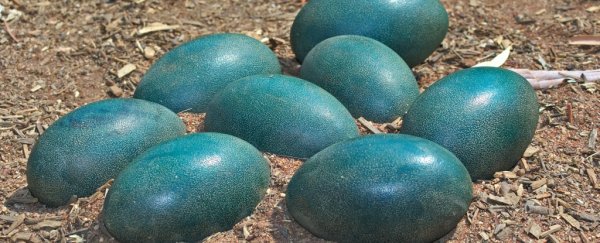Bird eggs come in a variety of shapes and sizes, but the stereotypical elongated, pointy-at-one-end, blunt-at-the-other design has at least one rather simple, if surprising purpose – it fits better inside a sleek bodied flying machine.
Scientists came to the conclusion after using a variety of tools to analyse tens of thousands of egg pictures representing a variety of birds, answering a question that even had old Aristotle perplexed.
It only takes a trip to the supermarket to learn that bird eggs aren't perfect spheres. And if you compare the humble chook egg with that of an ostrich you'll also see that not all eggs are the same shape.
The Greek philosopher Aristotle figured if the chick inside was female, the pointed end was sharper. We've come a long way since Aristotle, but the question remains – why are eggs shaped the way they are?
To keep things simple, an international team of researchers reduced egg morphology to a pair of variables – their asymmetry, or difference between the pointed end and the blunt end, and their ellipticity, or how long and oval the egg is.
They used a database of 49,175 egg photographs covering 1400 species of living and extinct birds to compare these two variables across the avian family tree, paying close attention to the parents' nesting behaviours, clutch sizes, diet, and flight ability.
This way they were able to correlate the diverse morphology of eggs with other characteristics of the species, producing something of an egg map like the one below.
 Stoddard et al/Science
Stoddard et al/Science
Traditional explanations have suggested the long, pointy shape of eggs is to ensure they don't roll too far from the nest, or to squeeze their way more easily out of a bird's cloaca. Not so, according to this study.
"In contrast to classic hypotheses, we discovered that flight may influence egg shape. Birds that are good fliers tend to lay asymmetric or elliptical eggs," says lead researcher Mary Caswell Stoddard from Princeton University.
Of all of the characteristics that differed among the birds, the measure describing the shape of the wing matched the differences in asymmetry and ellipticity the best.
Having wings that make flying more efficient and allow birds to venture further from home seems to match having longer or pointier eggs.
"Variation across species in the size and shape of their eggs is not simply random but is instead related to differences in ecology, particularly the extent to which each species is designed for strong and streamlined flight," says researcher Joseph Tobias from Imperial College London.
While the study doesn't support a specific cause, it could all come down to how birds manage to pack maximum baby bird into a 3D shape so that it can still fit snugly inside a sleek, aerodynamic body.
For example, while penguins also have elongated eggs, they could be the exception that proves the rule; they still need streamlined bodies to swim.
Variations in egg shape are the determined by slight differences in its membrane rather than its shell, meaning only minor tweaks would be needed for a bird to evolve a whole range of egg morphologies.
"By adjusting two basic properties – changes in the thickness of the egg membrane as a function of location, and a pressure jump across the membrane – we show that our model can produce a wide variety of egg shapes, encompassing the entire range of observations," says Harvard University researcher L. Mahadevan.
The researchers can only speculate on whether the body shape for flight directly affects the symmetry and elongation of the egg's shape, or if there are other related factors.
There is also the question of why different bird groups used different solutions to the egg problem, with some making eggs longer, others pointier, and others still having both solutions.
Looking back to the ancestors of birds might provide some clues.
"The idea that powered flight and pointy eggs evolved around the same time is particularly intriguing," says Stoddard.
"Moving forward, we are excited to explore how eggs changed shape during the dinosaur-to-bird transition."
Some theropod dinosaurs were able to lay pointy eggs, while squeezing eggs into an ellipse seems to be a trick evolved much earlier in ancient reptiles.
Research such as this often raises more questions than it answers. At least we can now put the runaway egg ball hypothesis to rest.
This research was published in Science.
